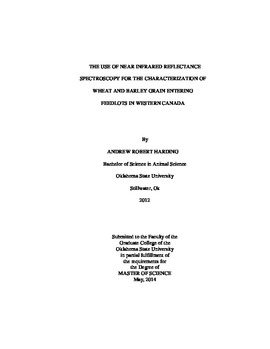| dc.contributor.advisor | Krehbiel, Clinton R. | |
| dc.contributor.author | Harding, Andrew Robert | |
| dc.date.accessioned | 2015-06-17T20:06:11Z | |
| dc.date.available | 2015-06-17T20:06:11Z | |
| dc.date.issued | 2014-05-01 | |
| dc.identifier.uri | https://hdl.handle.net/11244/14871 | |
| dc.description.abstract | The first experiment evaluated the use of near infrared reflectance spectroscopy (NIRS) for the nutrient prediction of wheat grain and the factors affecting in vitro dry matter digestibility (IVDMD) and in vitro kinetics of gas production of wheat grain. Wheat samples (n = 75) were selected from three feedlots in Alberta from September 2011 to April 2012 to represent a range in DM, CP, starch, and fat. The prediction models for DM, CP, and starch were tested and the effect of each nutrient on in vitro fermentation parameters were evaluated. A second experiment was conducted evaluating the effects of a barley spectra index on in vitro fermentation parameters and feedlot performance of yearling cattle. Results of the first experiment demonstrate that NIRS can accurately predict (R2 = 0.90) the CP content but not DM or starch (R2 = 0.17 and 0.02, respectively) across a broad range of composition. High DM samples had greater IVDMD (P < 0.05) than low and medium DM samples. Rate of gas production of high starch samples was lower than low starch samples and higher for high CP samples than medium and low CP samples. Results of experiment two indicate that segregating barley by spectra index may improve cattle performance by minimizing variability in substrate supplied to the rumen. Cattle fed LOW, MED, or HIGH spectra index barley had greater DMI (P = 0.02), tended to have greater HCW and live- and carcass adjusted ADG (P = 0.08, 0.09, 0.07, respectively) than cattle fed the unsegregated CON. Likelihood of Yield Grade 1 carcasses was greatest (P = 0.05) in steers fed MED treatment barley. As treatment group increased there was: a linear decrease in DM (P = 0.02); linear increase in CP (P < 0.01); a tendency for a linear decrease in starch (P = 0.07); linear decrease in the color variables brightness and red:green scale (P = 0.02 and 0.04, respectively); and linear increases in 1,000-kernel weight and kernel diameter (P < 0.05). | |
| dc.format | application/pdf | |
| dc.language | en_US | |
| dc.publisher | Oklahoma State University | |
| dc.rights | Copyright is held by the author who has granted the Oklahoma State University Library the non-exclusive right to share this material in its institutional repository. Contact Digital Library Services at lib-dls@okstate.edu or 405-744-9161 for the permission policy on the use, reproduction or distribution of this material. | |
| dc.title | Use of near Infrared Reflectance Spectroscopy for the Characterization of Wheat and Barley Grain Entering Feedlots in Western Canada | |
| dc.type | text | |
| dc.contributor.committeeMember | Lalman, David | |
| dc.contributor.committeeMember | Step, D. L. | |
| osu.filename | Harding_okstate_0664M_13385.pdf | |
| osu.accesstype | Open Access | |
| dc.description.department | Animal Science | |
| dc.type.genre | Thesis | |
| dc.subject.keywords | barley | |
| dc.subject.keywords | cattle | |
| dc.subject.keywords | feedlot | |
| dc.subject.keywords | near infrared reflectance spectroscopy | |
| dc.subject.keywords | wheat | |
